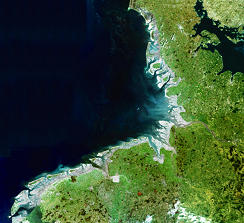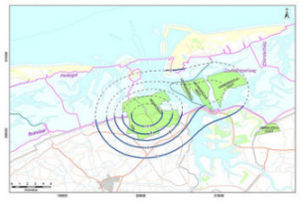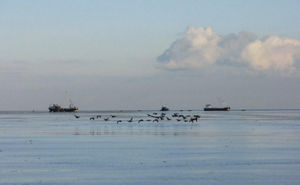Carrying capacity and development of the Wadden Sea
Contents
Introduction
Development in or nearby a protected area like the Wadden Sea can only proceed under special conditions and as long as there is no adverse effect on the carrying capacity and conservation targets. Meeting the legal requirements in coastal and estuarine areas presents great challenges when it comes to assessing the potential impacts of projects and activities. These challenges lie in assessing the potential impacts of a project or activity in these highly dynamic environments against a changing baseline due to e.g. climate change. This complexity and uncertainty means that the significance of effects is often subject to debate. In addition, coastal zones are generally already heavily developed, and subject to increasing ressure for more development. Therefore almost all new developments have a potential for significant effects on protected wildlife and there is little space left for alternative locations or compensation areas. The aim of this article is to identify ways to handle some of the development issues in the Wadden Sea.
Rigid legislation versus a dynamic world
Throughout history, coastal areas have attracted many people and have been major centres of population. Nowadays, more than 50% of the world's population live, work, and spend their leisure time in deltas, coastal areas and river basins. The fertile surroundings don’t just attract people. Many species use estuaries at some point in their life cycle, either to rest, to breed, to feed, as migratory route or as nursery. All this activity has made estuaries vulnerable: soft soil subsides, the sea level is rising, river levels are unpredictable and development pressure on space and the environment is on the increase. Due to these interactions, the ecological status has often deteriorated. In order to restore and protect nature, several EU Directives have been agreed upon. The Habitat and Bird Directives oblige EU member states to set conservation targets for specific species and habitat types. The Water Framework Directive gives the same sort of obligation as the Bird Directive for reaching the ‘good ecological status’ in water bodies including estuaries and coastal zone areas. The current legal framework does not give justice to the dynamics in coastal ecosystem. For example, it does not make sense to set rigid targets for mussel populations for the Wadden Sea while at the same time water tempature is rising due to climate change or the competition for habitat and food is increasing due to the invasion of Pacific Oysters in the area. An alternative way of setting targets is to set criteria for the ecosystem processess rather than the ecosystem status and to describe plausible developments by scenario analysis. In current practice, one can avoid being trapped in rigid legislation by working together with all stakeholders at an early stage of project planning. This calls for an adaptive management strategy.
Adaptive management
The application of adaptive management is discussed for some of the human activities that are possible in the Wadden Sea.
Extraction of natural gas
Extraction of natural gas approx. 4 km below the surface of the Dutch Wadden Sea is an activity of great national importance. The recent licensing procedure for new gas extraction and resulting subsidence of the seabed is regarded as a good example of adaptive management. It comprise of a precribed process control and monitoring. Gas extraction is conducted from the mainland. The resulting subsidence of the seabed touches on the geophysical part of the Wadden Sea ecosystem directly. For the prediction of geophysical responses a well-established mechanistic approach exists, which can be validated and improved with existing monitoring techniques. The responses of the biological components of the ecosystem are less well known and predictable, once soil subsidence and sea level rise would increase the basin volume above the value which certainly can be met by net sedimentation rates. The licensing therefore is based on a maximum allowable subsidence, thus keeping clear of potential ecological effects. A necessary requirement met is that gas extraction is a slowly developing activity, the rate of which can be almost directly controlled (start at a “safe scale” possible). Further favourable factors are: the existence of (a) a long time series of geophysical monitoring and modelling of subsidence as related to existing gas exstraction schemes (b) understanding of net sedimentation rates, (c) a long time series of biological and sedimentation monitoring measurements since the 1980s. Decrease or stoppage of gas extraction could be legally forced in case unexpected measurable changes would occur related to gas exstraction.
Tidal energy
The global community has a responsibility to exploit renewable energy resources. The fully predictable tidal energy offers a useful complement to variable wind and wave energy sources. The Wadden Sea could theoretically provide a significant fraction of the 2020 renewable energy target for Germany, Holland and Denmark (the equivalent of between 3 to12 1-GW power stations). However, tidal energy extraction by impounded barriers/offshore lagoons is likely to be excessively expensive financially and ecologically. It contradicts with the conservation goals for the habitat types of the Wadden Sea. In contrast the ecological impact of free-stream tidal turbines should be much more localised. High water current values (about 2 m/sec is required) in the Wadden Sea inlets could make these locations suitable sites for tidal energy. However, the required installations could impact negatively on shipping and be excessively exposed for servicing/installation.
Aquaculture
Aquaculture is becoming an increasingly important source of proteins and income worldwide. In the case of the Wadden Sea, it might be an innovation for mussel fisheries. Rough calculation suggests that 100.000 tons of mussels can be produced in an area of 15 km2 if deep tidal gullies are used. Mussel culture can be seen as a supplement or alternative to mussel fisheries in the Wadden Sea. Such replacement is in line with the global trend from capture fishery to aquaculture. Mussel culture may also alleviate some of the changes caused by global warming, e.g. decrease in plaice recruitment, increase in Pacific Oyster abundance etc. However, such suggestions might be considered controversial as effects on the Wadden Sea ecosystem have not been evaluated in detail.
It is concluded that for both tidal energy and aquaculture ecological modelling is required before ruling out the possibility in the Wadden Sea due to conflicting interests (allocation of primary production, use of suitable space). If there are uncertainties about any activity that might affect the Wadden Sea, and if research doesn’t provide an answer to the problems, then the [Precautionary_principle|precautionary principle]] should be adopted. Especially in areas where we don’t have a good grip on the dynamics, human use must either be flexible and adaptable or be on ‘the safe side’.
Eutrophication
Measures to reduce nutrient loads over the last few decades have been successful and a concomitant decrease in phytoplankton biomass is clear, as is the recovery of Seagrass in the Northern part of the Wadden Sea. However, present species dynamics show a significant deviation from (historic) reference conditions. OSPAR and Water Framework Directive goals have not yet been reached. With our current state of knowledge and due to the complexity of the ecosystem with non-linear interactions it is impossible to predict which level of carrying capacity can be reached for specific groups of organisms or trophic levels, under different levels of eutrophication. Again, this calls for an adaptive management strategy.
Carrying capacity in the decision making process
The Wadden Sea is a dynamic area. Therefore the process for its development asks for a dynamic approach. Determining the carrying capacity gives guidance in the process of developing adaptive management for a given project or activity. Defining the carrying capacity requires a clear decision making process, in which all parties are involved in an early stage (scientists, stakeholders from industry, NGO´s, general public, policy makers). The existing Trilateral Ministerial Conferences offer an excellent platform to agree upon carrying capacity. Although the Wadden Sea was subject to extensive research, there are still a lot of knowledge gaps. At the same time decision makers need to match objectives from all the different relevant legislations. Practical experiences brought in by stakeholders are necessary to confirm if the objectives are realistic.
References
The article is the outcome of a workshop among a group of people involved in research, policy and management of coastal zones from Denmark, Germany, The Netherlands and the UK including Flemming Møhlenberg (DHI), David Prandle, Fransiscus Colijn, Clivia Haese (GKKS), Folkert de Jong (CCWS Secretary), Justus van Beusekom, Ragnhild and Harald Asmus (AWI-Sylt ), Michael Assouline (Corila), Joop Marquenie (NAM), Myra Kremer (DG Water), Florence Bloemkolk (Rijkswaterstaat WD), Geert van Wirdum (TNO), Maria van Leeuwe (Waddenvereniging), Anna Kroon (TU Delft), Klaas Deen (Waddenacademie), Jan-Theo Ijnsen (Rijkswaterstaat N Nederland), Lian Zigterman (WUR), Johan Krol (Natuurcentrum Ameland), Bert van der Valk, Albert Oost, Patricia Schouten, Claudette Spiteri (Deltares), Joost Stronkhorst (chairman). The workshop was held within the framework of a European network project ENCORA from 29-31 October 2008 at Ameland, The Netherlands.
Internal Links
- Carrying_capacity_analysis
- Water_Framework_Directive
- Birds Directive, Habitats Directive, NATURA 2000
External Links
Please note that others may also have edited the contents of this article.
|







